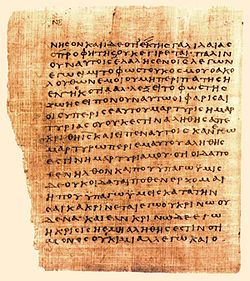- Papyrus 66
-
Manuscrits du Nouveau Testament
Papyri • Onciale • Minuscules • LectionnairePapyrus  66
66nom P. Bodmer II texte Jean 1:1-6:11; 6:35-14:26,29-30; 15:2-26; 16:2-4,6-7; 16:10-20:20,22-23; 20:25-21:9,12,17 date ~200 trouvé Jabal Abu Mana maintenant à Bodmer Library, Genève citer Martin, Victor. Papyrus Bodmer II: Evangile de Jean 1-14 (1956); Martin, Victor. Papyrus Bodmer II: Evangile de Jean 14-21 (1958); Martin, Victor and Barns, J.W.B. Papyrus Bodmer II: Supplément, Evangile de Jean 14-21 (1962); Aland, Kurt. "Neue neutestamentliche Papyri III" NTS 20 (1974) pp. 357-381 dimension 39 folios; 14.2×16.2 cm; 15-25 Lignes par page type libre, écrivain et de petits éditeurs Catégorie I note très proche de P75, B, 0162
Le Papyrus 66 (référencé sous le sigle 66), également appelé codex saint Jean, est un codex presque complet de l'Évangile selon Jean. Il fait partie de la collection des Papyri Bodmer.
66), également appelé codex saint Jean, est un codex presque complet de l'Évangile selon Jean. Il fait partie de la collection des Papyri Bodmer.Sommaire
Description
Le manuscrit contient Jean 1:1-6:11, 6:35b-14:26, 29-30; 15:2-26; 16:2-4, 6-7; 16:10-20:20, 22-23; 20:25-21:9, 12, 17[1]. C'est un des plus anciens manuscrits connus du Nouveau Testament. Daté des alentours de 200[2], il appartient au groupe des textes chrétiens d'Alexandrie où se développait une culture chrétienne florissante à la fin du IIe siècle[3]. Il est proche du texte du codex sinaïticus[4].
Le Papyrus 66 ne contient pas l'épisode de la femme adultère (Jean 7,53-8,11)[5],[6]; il n'est pas une transcription bout-à-bout de l'Évangile selon Jean, mais de passages choisis. Il utilise fréquemment des Nomina sacra.
Le manuscrit est conservé à la Bibliothèque Bodmer à Cologny près de Genève. Il est composé de 39 folios (soit 78 feuilles et 156 pages), d'une taille de 14.2cm x 16.2 cm pour chaque feuille avec 15 à 25 lignes par page.
Selon de récentes études menées par les spécialistes des papyri Karyn Berner[7] et Philip Comfort[8], il est évident que
 66 est le fruit du travail de trois individus: un scribe professionnel, un correcteur principal et un correcteur secondaire.
66 est le fruit du travail de trois individus: un scribe professionnel, un correcteur principal et un correcteur secondaire.Une transcription de P66 est disponible dans l'ouvrage Text of the Earliest New Testament Greek manuscripts (cf bibliographie).
Histoire du Papyrus 66
Le manuscrit a été découvert en 1952 à Pabau près de Dishna, en Égypte.
Notes et références
- (en) Philip W. Comfort, David P. Barrett, The Text of the Earliest New Testament Greek Manuscripts, Wheaton, Tyndale House Publishers, 2001 (ISBN 978-0-8423-5265-9) (LCCN 00064937), p. 376
- Herbert Hunger. Zur Datierung des Papyrus Bodmer II (P66) (1960)
- (en) Kurt Aland et Barbara Aland (trad. Erroll F. Rhodes), The Text of the New Testament : An Introduction to the Critical Editions and to the Theory and Practice of Modern Textual Criticism, Grand Rapids, Michigan, William B. Eerdmans Publishing Company, 1995, 2e éd. (ISBN 987-0-8028-4098-1) [lire en ligne], p. 97
- Trois manuscrits célèbres in Le Monde de la Bible n°185, sept. oct. 2008, p. 36
- Philip Comfort et David Barett. Text of the Earliest New Testament Greek manuscripts page 376 (1999)
- NA26, p. 273.
- Karyn Berner. Papyrus Bodmer II,
 66: A re-evaluation of the Correctors and corrections (1993)
66: A re-evaluation of the Correctors and corrections (1993) - Philip Comfort. The Scribe as Interpreter: A new Look at New Testament Textual Criticism according to Reader-Reception Theory (1996)
Bibliographie
- Philip Comfort et David Barett, Text of the Earliest New Testament Greek manuscripts, Tyndale House Publishers, 2001
- Jean Zumstein, L'Evangile selon Jean, Presses universitaires de France, 2008. Reproduction intégrale du Papyrus 66 avec traduction et introduction. Excellent ouvrage
Voir aussi
Liens internes
Liens externes
Catégories :- Papyrus
- Manuscrit du Nouveau Testament en grec
Wikimedia Foundation. 2010.

